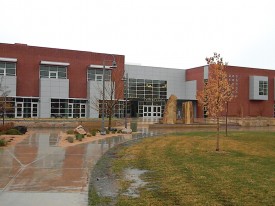News Reporter
Mesa State College has seen its fair share of change in the 86 years since it was founded. Only 39 students were enrolled in it’s first year, 1925. The college first started offering baccalaureate degree programs in 1974, with graduate degrees following 20 years later. Now, as the college considers another change, a new name, it’s worth looking back at the history of some everyday names around campus.
Students know that the name Wubben refers to the science center. Tomlinson is the name of the library on campus. Houston is the building that is under seemingly endless construction. But what is the history behind those names? Who were they? And what did they do to get buildings named after them?
“You either have to be a president of the college, or make a very significant financial donation to have a building named after you,” Director of Media Relations Dana Nunn said.
Most of the buildings on campus were named after Mesa State College presidents. Houston Hall, which has the reputation of being the first building on campus, is named for Dr. Clifford G. Houston, who was Dean of the college. From 1932 to 1937, when it was known as Grand Junction Junior College, Dr. Houston reached out to high school students and helped them enroll here. He visited local high schools on his own time, spending his money to recruit high school seniors and boost the college’s reputation.
When the enrollment reached 200 students, a number of improvements took place under Dr. Houston’s administration. The buildings were upgraded in order to receive an “A” rating from the insurance inspector. Now, Houston Hall stands to commemorate both Dr. Clifford Houston as well as his father, Elmer G. (Pop) Houston, who was the superintendent of buildings and grounds from 1931 to 1937.
After Dr. Houston’s resignation in 1937, Dr. Horace J. Wubben took the position of president. A new building had to be constructed to accommodate the expanding student body. The construction took place during Dr. Wubben’s presidency and the name of the institution changed from Grand Junction Junior College to Mesa College. Dr. Wubben improved the academic system of the college by simplifying the courses in the catalogs, as well as creating an attendance policy. While Wubben was president, World War II broke out, and the college offered special courses including civilian pilot training, first aid hygiene, radio communication and metal work. In 1963, Dr. Wubben resigned from his position. In the 26 years that he was President, the enrollment had gone from 270 students to 1,300 students.
For those that spend a significant amount of time in the library, the story of Dr. John Tomlinson will be interesting. It was under President Tomlinson’s guidance that Mesa College transformed from a three-year program to a four-year degree granting institution. In 1976, Mesa College became a part of the National Association of Intercollegiate Athletics (NAIA). KMSA, the student run radio station also began during that year and enrollment reached 2,278 students. During Dr. Tomlinson’s presidency, from 1975 to 1989, several new classrooms were added to buildings, the Walnut Ridge Apartments were built and the new library was completed. Upon his resignation in 1989, the library was named for Dr. Tomlinson.
“The square footage of campus right now is double of what it was when the college first started,” Nunn said. “It’s inevitable that the other buildings, like the Fine Arts Building and the ACB, will receive names sometime in the future.”
Mesa State College, soon to be renamed, is no stranger to change. Every building on campus has a story behind it, and an influential person to whom it’s dedicated.
“The history is important and interesting,” Nunn said. “But I’m interested in the future of this campus.”
cmfoster@mesastate.edu

Recent Comments